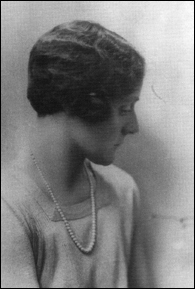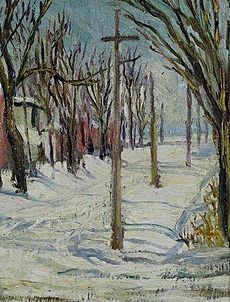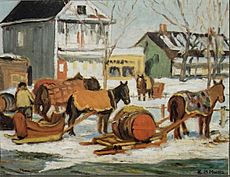Kathleen Morris facts for kids
Quick facts for kids
Kathleen Morris
|
|
|---|---|

Kathleen Morris, 1930
|
|
| Born |
Kathleen Moir Morris
December 2, 1893 Montreal, Quebec, Canada
|
| Died | December 20, 1986 (aged 93) Rawdon, Quebec, Canada
|
| Education | Art Association of Montreal |
| Known for | Painter |
Kathleen "Kay" Moir Morris RCA (born December 2, 1893 – died December 20, 1986) was a Canadian painter. She was also a member of a famous art group called the Beaver Hall Group.
Contents
About Kathleen Morris
Kathleen was the fourth child and only daughter of Montague John Morris and Eliza Howard Bell. She was born in Montreal, Quebec, and grew up there.
She studied art for ten years (1907–1917) at the Art Association of Montreal. Her teacher was William Brymner. She also learned from Maurice Cullen during his outdoor sketching classes.
Her father passed away in 1914. In the same year, she started showing her paintings at art exhibitions. In the early 1920s, she joined the Beaver Hall Group. This was a group of artists who wanted to paint in new and modern ways. In 1921, she also began to show her art with the Ontario Society of Artists.
In 1922, Kathleen moved to Ottawa, Ontario, to live with her mother. Her mother, Eliza Bell, was a strong woman who believed in women's rights. She really encouraged Kathleen to follow her dream of becoming an artist. It was hard for women to become successful artists back then. Kathleen's mother's cousin, a portrait painter named Robert Harris, also helped her with her art career.
The Beaver Hall Group officially ended in 1922. However, Kathleen still showed her paintings in their exhibitions while living in Ottawa. She also showed her art in other countries. She moved back to the Montreal area in 1929 and lived there for the rest of her life. In 1929, she became a member of the Royal Canadian Academy of Arts.
Kathleen found inspiration from the artist James Wilson Morrice. He even bought one of her paintings! Her art has been compared to the work of another famous Canadian painter, A. Y. Jackson. In 1930, she won an award called Honourable mention at the Second Willingdon Arts Competition. She placed second, right after Frederick Varley.
Her Art Style and Paintings
Kathleen Morris often painted scenes from Quebec. She painted busy city streets and quiet country areas before they became too modern. She wanted to show that simple, old ways of life could be a peaceful escape from the modern world.
From her first paintings, which had thick paint, to her later landscapes with soft colors, Kathleen had a special style. This style made her different from other artists of her time. She would make quick sketches first. Then, she would simplify the shapes and add bold, thick patches of color to her paintings.
Her paintings showed how much she loved the world around her and appreciated simple living. She also cared deeply about animals. She even spoke out publicly against the yearly seal hunt. Every summer, she spent two months at a small cottage in Marshall's Bay, Ontario. This cottage had been in her family for over a hundred years. There, she would paint fields and sunsets. She also loved painting animals like cows and sheep. However, art galleries preferred her city scenes. So, she spent most of her time turning her winter sketches of towns into bigger paintings.
"I won a hundred dollars in the Ontario Humane Society Lottery the other day. They, and the International Fund for Animal Welfare, are running a campaign to abolish the Leg Hold Trap in Fredericton, N.B., and I am very interested in that as I think it is the worst thing of all. So sent fifty to one and fifty to the other. I could not have done it otherwise and that was found money. They have done it in England and different parts of the States but I am afraid they will never do it here but the only thing is to try. Think of having your finger caught in a car door for a week or longer and no food or water and to be killed by another animal or a brutal trapper. In these days when they can do such wonderful things they surely could make very nice artificial furs but of course the furriers will fight it tooth and nail. Government should force them to use the trap that kills. The women of course the most to blame."
Kathleen Morris's paintings are sometimes compared to the work of Les Nabis. This was a group of French painters from the 1890s. They used bold colors and patterns, like Paul Gauguin. Like them, Kathleen painted what she saw in her own way. She let color guide her more than shape. Her paintings show bravery, both in her personal life and in her art. This puts her in the same group as artists like David Milne. Her art seems to be on the edge between what is real and what is unseen. It lets you complete the picture in your mind and see into the artist's heart. Kathleen painted just like she was: humble but very present.
In 1937, her work was shown at the Royal Institute Galleries in London. A critic named W.G. Constable said Kathleen Morris was an excellent example of a new generation of Impressionist painters. Many of her paintings don't have dates, and she sometimes used the same title more than once. Still, her paintings are lovely reminders of a time gone by.
How She Was Recognized
In 1923, a Montreal newspaper called La Presse started noticing her work. A Canadian writer, Albert Laberge, said her art was very interesting. In 1924 and 1927, her name was in the headlines of reviews for the yearly Art Association of Montreal spring exhibition.
In 1928, one of her paintings of a Quebec fish market was shown in the Toronto Telegram newspaper. The title was Canadian Art Reaches Peak at R.C.A. Show. The magazine Canadian Homes and Gardens also showed one of her paintings called Sunday Morning in 1932. In 1980, her painting McGill Cab Stand, 1927 was chosen for a series of Christmas postage stamps by Canada Post.
Exhibitions of Her Work
Between 1914 and 1940, Kathleen's art was regularly shown. She exhibited with the Beaver Hall Group and the Canadian Group of Painters. Her work was also seen at the yearly Spring Exhibitions with the Art Association of Montreal. She also showed her art at annual shows at the Art Gallery of Ontario with the Ontario Society of Artists and at the Royal Canadian Academy exhibitions.
She also took part in these international group shows:
- Canadian Section of Fine Arts, British Empire Exhibition, Wembley, England (1924, 1925)
- First Pan-American Exhibition, 1925
- Exposition d'art canadien, Musée du Jeu de Paume, Paris, France, 1927
- Canadian art at the British Empire Trade Exhibition, Buenos Aires, Argentina, 1931
- Contemporary Canadian Painting circulated in Southern Dominions of British Empire in 1936
- Exhibition of Paintings, Drawings and Sculpture by Artists of the British Empire Overseas, Royal Institute Galleries, London, Eng., 1937
- A Century of Canadian Art, Tate Gallery, London, Eng., 1938
- 1939 New York World's Fair
- Pintura Canadense Contemporanea, Rio de Janeiro, Brazil, 1944
- Canadian Women Artists, Riverside Museum, New York, 1947
- Contemporary Canadian Painting, Canadian Club, New York, 1948
- Festival of Britain, London, 1951
Kathleen also had her own shows or shows with one other artist. These were held at the Art Association of Montreal in 1939, and the Montreal Arts Club in 1956 and 1962. After one of these shows, a critic named Dorothy Pfeiffer wrote:
"Kathleen Morris's work appears all of a piece. Her solidly composed souvenirs of Old Montreal and its environs should be collectors' treasures. ...Such painting brings peace to the soul. It is humane, it is technically authoritative, it is the personal expression of the joy of life and of tangible emotion by a gifted, forthright, fearless artist."
In 1983, the Agnes Etherington Art Centre at Queen's University held a special show of her work. This kind of show looks back at an artist's entire career.
Art Collections
Kathleen Morris's paintings are in many important art galleries and museums. Some of these include:
- Art Gallery of Greater Victoria
- Art Gallery of Hamilton
- Hart House at the University of Toronto
- Montreal Museum of Fine Arts
- Musée national des beaux-arts du Québec
- Corcoran Gallery in Washington
- National Gallery of Canada
- Mackenzie King Museum
- Power Corporation of Canada
- McCord Museum
- Library and Archives Canada
- Embassy of Canada, Paris
Her Personal Life
Kathleen Morris had Cerebral palsy. This is a condition that affects movement and balance. It made some physical things challenging for her. However, it did not stop her from enjoying life. She never got married. After her mother passed away in 1948, she lived with her brother Harold. In 1978, she had a stroke and could no longer paint.
Kathleen Morris died in Rawdon, Quebec, when she was 93 years old. Her obituary (a notice of her death) asked for donations to be made to the Society for the Prevention of Cruelty to Animals in her memory.





